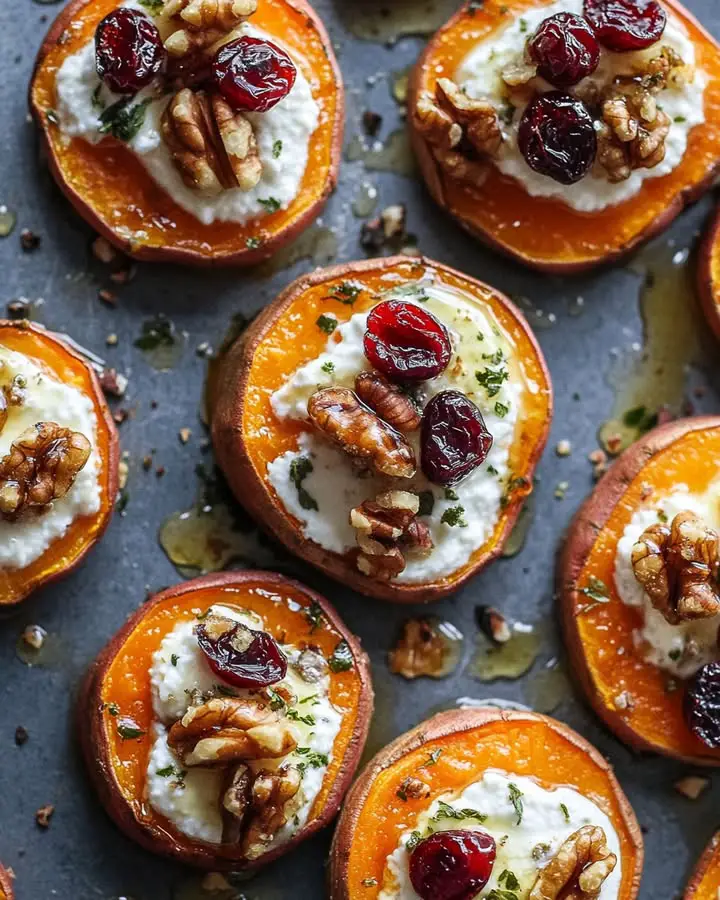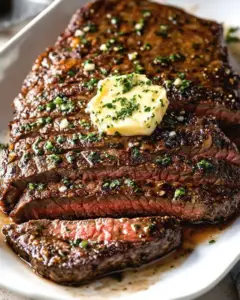Roasted Sweet Potato Rounds with Herbed Ricotta, Walnuts, and Cranberries: A Flavorful Delight
Unlock the perfect blend of flavors with these Roasted Sweet Potato Rounds with Herbed Ricotta, Walnuts, and Cranberries. This delightful combination creates a symphony of taste that is both vibrant and comforting, offering a unique twist on traditional sweet potato dishes. As the sweet potatoes roast to a perfect caramelized finish, the creamy herbed ricotta, crunchy walnuts, and tart cranberries layer together to create a mouthwatering culinary experience that is sure to be a hit at your next dinner party.
The sweet potato’s natural sweetness pairs beautifully with the herbs in the ricotta, creating a savory-sweet balance that is enhanced by the nutty crunch of walnuts and the bright tartness of cranberries. This dish not only appeals to the palate but also offers an enticing visual with its vibrant orange rounds and colorful toppings. Perfect for showcasing your culinary skills, this easy-to-make recipe is ideal for any home cook looking to impress family and friends.
Quick Recipe Highlights
- Flavor Profile: The roasted sweet potatoes offer a sweet and earthy flavor, complemented by the creamy, herby notes of ricotta and the sharpness of cranberries.
- Texture: Experience a crispy outer layer with a soft, creamy center, punctuated by the satisfying crunch of walnuts.
- Aroma: The fragrant blend of roasted herbs fills your kitchen, mingling with the sweet scent of caramelizing potatoes.
- Visual Appeal: Enjoy the beautiful contrast of vibrant orange sweet potatoes against the white ricotta and red cranberries.
- Skill Level Needed: Perfect for beginners, this recipe requires minimal skill yet delivers maximum flavor impact.
- Special Equipment: A baking sheet and a mixing bowl are all you need for this simple yet impressive dish.
Recipe Overview
- Difficulty Level: Rated as easy, this recipe is designed to be foolproof, making it accessible to cooks of all levels. The straightforward steps ensure success every time.
- Category: Perfect as an appetizer or side dish, it’s versatile enough for casual family meals or festive gatherings.
- Cuisine: Inspired by modern American cuisine with a hint of Mediterranean flair owing to the use of herbed ricotta.
- Cost: Budget-friendly, this recipe utilizes affordable and easily accessible ingredients to create a gourmet experience.
- Season: Best enjoyed in the fall when sweet potatoes are at their peak, bringing comfort and warmth to cooler evenings.
- Occasion: Ideal for holiday parties, casual dinners, or as a contribution to a potluck, offering uniqueness and crowd-pleasing appeal.
Why You’ll Love This Recipe
The taste and texture of these roasted sweet potato rounds with herbed ricotta, walnuts, and cranberries are simply irresistible. The roasted sweet potatoes provide a tender yet firm base, while the herbed ricotta adds a smooth, creamy layer accented by the earthy sweetness of walnuts and the bright tartness of cranberries. This fusion of flavors creates a satisfying and harmonious tasting experience that excites the palate.
Convenience is another reason to fall in love with this recipe. With minimal preparation and simple cooking techniques, you can achieve gourmet results without the stress. This means you can spend less time in the kitchen and more time enjoying the company of friends and family, making it perfect for both parties and quiet family dinners.
This dish also comes with the benefit of being nutrition-conscious. Sweet potatoes are rich in vitamins and fiber, while the addition of walnuts and cranberries contributes healthy fats and antioxidants. Each ingredient plays its part in making this not only a flavorful choice but also a nutritious one that can contribute to a balanced diet.
From a social perspective, these sweet potato rounds are a conversation starter. Their stunning presentation and unique flavor profile invite guests to engage and share their appreciation for the dish, making it a stellar addition to any entertaining menu. You’ll appreciate the ease at which this dish becomes the focal point of your meal.
Lastly, the cost-effectiveness and accessibility of this recipe make it a popular choice for home cooks. Utilizing readily available ingredients keeps your grocery bill in check, while the simplicity of preparation ensures that both novice and experienced cooks can produce impressive results without unnecessary complexity or expensive tools.
Historical Background and Cultural Significance
The recipe for roasted sweet potatoes has a rich history rooted in Southern American cuisine, where sweet potatoes have long been a staple. Traditionally, these tubers were enjoyed simply roasted or mashed, embodying the comfort and sustenance of home-cooked Southern meals. Over time, the inclusion of diverse ingredients such as herbed ricotta and cranberries reflects the fusion of various culinary influences in today’s culinary landscape.
Sweet potatoes have held cultural significance primarily in the Southern United States, where they were grown abundantly and cherished as both a dietary staple and a symbol of fertility and abundance. Their adaptability in recipes represents the rich tapestry of culinary innovation driven by historical trade and cultural exchange.
The evolution of sweet potato recipes demonstrates a remarkable transformation, from essential comfort food to versatile, gourmet fare. This modern recipe reflects how contemporary culinary trends embrace traditional ingredients while exploring new flavor profiles and presentation styles that appeal to broader palates.
Regional variations are testament to this recipe’s adaptability. For instance, the use of spices like cinnamon or cardamom adds an eastern touch, while different cheeses can shift the profile to more Mediterranean or even Latin influences. Such flexibility highlights the roasted sweet potato’s universal appeal across cultures and seasonal settings.
Ingredient Deep Dive
Sweet potatoes have long been celebrated in various cuisines worldwide due to their cultural significance and nutritional properties. Historically, sweet potatoes have been associated with abundance and festivity, especially in American traditions. Their rich orange hue and natural sweetness make them a favorite in autumnal dishes, symbolizing harvest and plenty.
Nutritionally, sweet potatoes are powerhouses of vitamins like A and C, along with dietary fiber, making them beneficial for eye health and digestion. When selecting sweet potatoes, opt for firm, smooth-skinned varieties free of blemishes for the best flavor. Store them in a cool, dry place to prolong shelf life, and should you need a substitution, consider using other root vegetables like yams or carrots.
Ricotta cheese, with its creamy texture and mild flavor, originates from Italy. Enriched with herbs, this cheese elevates dishes with a sophisticated texture and taste. Known for its calcium content, ricotta supports bone health, making it both a delicious and nutritious choice. When purchasing, choose ricotta with a short ingredient list and avoid brands with stabilizers for an authentic experience.
Store fresh ricotta in the refrigerator and consume it within a week to ensure freshness. Should ricotta be unavailable, cottage cheese can act as a substitute, although it offers a grainier texture. The addition of herbs like thyme or basil enhances ricotta’s flavor, making it an adaptable component in many savory applications.
Common Mistakes to Avoid
- Skipping the seasoning: Failing to season each layer can lead to a bland dish. Ensure each component is seasoned to enhance overall flavor.
- Overcooking sweet potatoes: Cook until just tender to avoid mushiness, preserving both texture and taste.
- Using pre-grated cheese: Freshly ricotta provides superior flavor and creaminess, while pre-grated options may include additives.
- Skipping resting time: Allow the rounds to cool slightly to help flavors meld and facilitate easier plating.
- Neglecting garnishes: A sprinkle of fresh herbs or a dash of salt enhances presentation and flavor.
- Using the wrong baking sheet: A heavy-duty sheet ensures even cooking; thin sheets may result in burning.
- Storing improperly: If making ahead, keep components separate to maintain freshness until serving.
- Inadequate mixing of ricotta: Ensure the ricotta is thoroughly mixed with herbs for consistent flavor distribution.
- Not tasting as you cook: Adjust seasoning throughout for optimal flavor balance.
- Ignoring portion sizes: Overcrowding the baking sheet can prevent proper browning. Use additional sheets if necessary.
Essential Techniques
Mastering the art of roasting is crucial for this recipe. Sweet potatoes must be evenly cut to ensure they cook consistently. Roast them until edges are caramelized but not burnt. This achieves the ideal combination of crisp exteriors with soft interiors, providing the dish’s foundation.
Creating herbed ricotta involves skillful mixing, where a balance of herbs elevates the cheese without overpowering it. Achieve this by using fresh herbs and tasting as you go to maintain a delicate flavor profile. When working with cranberries, their tartness requires balance, so add them sparingly and taste frequently for the preferred level of acidity.
Perfecting these techniques ensures the experience of rich, blended flavors with each bite, presenting you as a proficient cook capable of delivering sophisticated dishes with ease. Understanding visual cues like color changes and texture firmness can indicate success, guiding cooks to repeatable, consistent results.
Pro Tips for Perfect Roasted Sweet Potato Rounds
For optimal roasting, preheat the oven thoroughly before inserting the sweet potatoes, enhancing even cooking and caramelization. Use parchment paper or a silicone mat on your baking sheet to prevent sticking and facilitate clean-up.
When assembling the dish, use a small offset spatula or the back of a spoon to spread the herbed ricotta evenly. This ensures a consistent layer without oversaturation, maintaining the perfect balance of cheese to sweet potato.
Toast walnuts gently to release oils and deepen flavor for additional richness in each bite. Observe the nuts closely while toasting to avoid burning, which can impart unwanted bitterness to your dish.
For an extra burst of flavor, incorporate a finishing drizzle of balsamic reduction over the finished rounds. This adds complexity and a touch of sweetness, harmonizing the dish’s flavor notes beautifully.
Prepare the cranberry part of the topping by briefly soaking dried cranberries in warm water or juice to plump them up and intensify their natural tartness, making them pop with each mouthful.
Consider using a mandolin slicer to achieve uniform slices. Consistency in thickness ensures even cooking and aids presentation by maintaining cohesive shape and size.
Engage variety by incorporating seasonal ingredients, such as different herbs or spices, to align with available produce, thereby maintaining the recipe’s adaptive nature while expanding its flavor boundaries.
Variations and Adaptations
Regional variations play a significant role in this dish. In Mediterranean influences, sun-dried tomatoes might replace cranberries, enhancing richness and color. A sprinkle of feta could substitute ricotta for a tangy twist true to the region’s culinary roots.
Seasonally, experiment with pumpkin or butternut squash rounds, offering a fun autumnal switch from sweet potatoes while maintaining similar textural qualities. These adaptations allow the dish to stay relevant throughout different holiday celebrations or events.
For dietary modifications, creating a vegan version is simple by using cashew cream in place of ricotta and toasted pine nuts instead of walnuts, keeping flavors complementary while aligning with vegan principles.
Flavors can be varied by integrating a hint of smoked paprika or cayenne in the seasoning, providing subtle heat and a rustic smokiness that layers beautifully with the naturally sweet components.
Texture modifications can involve dusting the rounds with crushed oats or breadcrumbs before roasting for additional crunch, offering a satisfying contrast that enhances the dish’s overall composition.
Serving and Presentation Guide
Define elegance in presentation by plating sweet potato rounds with a strategic, artistic placement. Experiment with height and layering, using tiered arrangements to enhance visual interest on the plate. Garnish with a sprinkling of freshly chopped herbs for color contrast and to signal freshness.
Consider accompanying with a fresh, lightly dressed arugula salad or a colorful vegetable medley to enhance the meal as a balanced celebration of flavors and textures, offering your guests complementary contrasts.
Serve at moderate warmth to allow flavors to develop while inviting immediate consumption. Prolonged cooling can diminish flavors, so a just-cooked freshness is preferred, while still easily held at buffet room temperatures when needed for larger event serving.
Ensure portions are sized appropriately, focusing on bite-sized rounds to encourage easy finger-food accessibility, supporting the overall casual yet sophisticated dining experience intended for shared settings.
Wine and Beverage Pairing
Wine pairings can elevate this dish significantly. Opt for an oaky Chardonnay or a sparkling white that complements the creamy ricotta and sweet-tart cranberries, enhancing the dish’s delicate balance with bright acidity.
Non-alcoholic alternatives include a lightly sparkling water with hints of lemon or a fresh, zesty lemonade that can cleanse the palate while complementing sweet and savory elements.
Consider serving a lightly spiced herbal tea, such as a cinnamon or ginger blend, alongside to echo and enhance the natural sweetness and warm spice notes in the dish. The aromatic qualities of these teas harmonize well, adding an extra layer of pleasure to your serving experience.
Serve all beverages moderately chilled to create a refreshing contrast against the warm dish and maintain aromatic integrity throughout tasting. Keep temperatures consistent to ensure the crisp appeal is retained from first to last sip.
Storage and Shelf Life
Post-cooking storage methods for this dish are straightforward. Keep wholly assembled in airtight containers in the refrigerator if you must store before serving. Ideally, consume within two days for peak taste and texture quality.
Maintain controlled humidity and cool temperatures to prolong shelf life without herb degradation. Transparency in storage containers can help identify any components nearing their limits, allowing timely consumption.
Signs of spoilage can include noticeable off-odors, visible mold, or a noticeably altered texture from what was originally intended. If any doubt exists regarding freshness, err on the side of caution.
For reheating, warm gently in a 300°F (150°C) oven until the fillings are just warmed through, maintaining the integrity of the assembled dish. Microwaving is not recommended, as it may alter the texture unfavorably.
Freezing is not ideal due to textural changes upon thawing, though the sweet potatoes alone, prepared and seasoned without additional toppings, can be frozen for later use. Thaw gently in the refrigerator before proceeding with fresh assembly.
Make Ahead Strategies
To optimize time, prepare sweet potatoes in advance by slicing and storing submerged in cold water to prevent oxidation. Keeps them fresh and ready for assembly when needed, helping manage hectic kitchen timelines.
Storage between steps involves keeping herbed ricotta refrigerated in a tightly sealed container to prevent drying out or off-flavors. Agitating occasionally can help maintain creaminess until final use.
Quality impact is minimal between stages when proper storage is adhered to, ensuring a seamless finish as fresh, non-prepped alternatives without degrading desired flavor or appearance.
If assembling in advance, maintain separation between components until just before serving to retain the best texture and flavor combination; this includes storing nuts and cranberries separately to avoid moisture transfer.
Reheat with intention, focusing on low, gentle heat application to warm without compromising the interconnected balance of ingredients, ensuring full enjoyment upon serving.
Adding fresh elements like additional herbs or a finishing salt just before serving can reintroduce brightness and appeal to prepped parts, allowing each bite to feel special and thoughtfully crafted.
Scaling Instructions
Adapting this dish for a larger crowd involves considerations for multiplying quantities while preserving the integrity and quality of the original recipe. When doubling, ensure sufficient baking sheets are available to prevent overcrowding and uneven cooking.
Equipment adjustments may require investing in more substantial mixing bowls or better oven racks to comfortably fit increased portions without affecting air circulation, critical for achieving even cooking results.
Timing extends marginally with larger batches due to slightly increased volumes, requiring vigilant temp monitoring and possibly staggered cooking commencement to compensate catering to larger banquet events or gatherings.
Storage presents more challenges when scaling, necessitating additional refrigerated or cool holding spaces to accommodate added components, each appropriately sealed and managed to retain freshness until needed.
Nutritional Deep Dive
Probing the nutritional angles of this recipe reveals a robust macro and micronutrient breakdown that supports overall health while delighting the palate. Sweet potatoes deliver substantial complex carbohydrates and fiber alongside potassium, beneficial for energy and digestive health.
Micronutrient analysis shows high levels of vitamin A, courtesy of the sweet potatoes, boosting immunity and eye health. The inclusion of cranberries and walnuts introduces antioxidants and healthy fats, contributing to heart health and satisfaction.
Health benefits span digestive, immune, and heart wellness fields, through thoughtful integration of nutrient-rich whole foods and balanced flavor profiles that meet both indulgence and nutritional expectations.
Dietary considerations acknowledge varied sensitivities — offering alternatives ensures all dietary preferences and needs are met without diminishing the dish’s enjoyment, particularly for gluten-free, dairy-free, or vegan guests.
Porportion analysis emphasizes sensible serving sizes that deliver a satisfying and nutritionally commendable mealtime experience, encouraging moderation without sacrificing completeness or enjoyment.
Dietary Adaptations
Gluten-Free: This recipe naturally falls within gluten-free bounds, requiring no grain-based modifications for the vast majority of ingredients, simplifying adaptation for those with celiac disease or gluten intolerance.
Dairy-Free: Replacing ricotta with cashew cream creates a seamless dairy-free alternative, maintaining creaminess and flavor integrity without sacrificing richness or cohesiveness in taste experience.
Vegan: The simple swap of plant-based cheese for the herbed ricotta and nuts for parmesan ensures a full-flavored vegan version, illustrating the recipe’s innate flexibility and adaptability for diverse dining audiences.
Low-Carb: To align with lower carb desires, adjusting serving sizes or substituting part of the sweet potato quantity with cauliflower can offer reduced carbohydrate intake while preserving dish essence.
Keto: Emphasizing walnut and cheese virtues allows this dish to align with keto principles, maximizing flavor contributions from fat-based ingredients and associations without compromising on culinary delight.
Paleo: For paleo dieters, this dish provides harmony through whole, unprocessed ingredients that adhere to ancestral eating principles, courtesy of naturally sweet and flavorful foundational components.
Low-FODMAP: While naturally supportive of a low-FODMAP approach, selecting compliant cheese and keeping portions mindful allows those following this inhibitory pattern to partake with confidence and joy.
Troubleshooting Guide
Textural adjustments may be necessary if components threaten to lose intended form through excessive moisture or improper roasting time frames. Analyzing cooked cues against recipe benchmarks guides correction.
Balance issues can be easily managed by slight seasoning increases or decreases; initially conservative amounts can be adjusted post-construction based on tasting feedback until true harmony emerges.
Temperature complications arise from inadequate oven calibration or heat loss during cooking. Verifying equipment consistency ensures adequate atmospheric conditions for expected cook and finish times within set ranges.
Equipment challenges include insufficient workspace or incorrectly chosen dish sizes, finding remedy through adequate preparation and tool selection that matches the scale and requirements perfectly.
Ingredient substitutions or seasonal variations sometimes demand slight improvisation to maintain consistency and fluid performance, drawing from a well-stocked pantry or thoughtful specialty alternatives.
Timing concerns alleviate when grace times are woven into prep plans, ensuring that assembly corresponds to serving readiness without undue rush and allowing a buffer for unforeseen recipe timing considerations.
Recipe Success Stories
Community feedback consistently speaks to the overwhelming satisfaction found with this recipe; guests and audiences delight in ease-of-prep and the complexity of flavors that belie the simplicity of the process.
Variation successes provide excitement and invitation to innovate, witnessing successful implementations like citrus zest enhancements or diverse nut incorporation that has delighted palates and sparked curiosity.
Adaptation stories often speak to the prowess of elevated staples that entice and captivate those new to herbed cheeses or roasted sweet potatoes, highlighting success in opening culinary exploration avenues.
Reader suggestions further the dish’s applicability, addressing seasonal recipes or entertaining themes while permitting refinements that maximize each aspect’s strengths, leading to delightful outcomes per taste and audience.
Photography tips emphasize dish visibility and color correctness, ensuring balanced illumination and clear contrasts that emphasize the sensory elements directly and beautifully documented online or within community shares.
Frequently Asked Questions
What makes this dish unique?
Answer: The fusion of roasted sweet potatoes with herbed ricotta, walnuts, and cranberries creates a complex flavor profile that blends sweet, savory, and tart notes, unlike many traditional sweet potato recipes.
Can I make this dish vegan?
Answer: Yes, you can substitute the ricotta with a vegan cream cheese or a blended cashew mixture to achieve similar texture and taste, making it compliant with a vegan diet.
How should I store leftovers?
Answer: Store in an airtight container in the refrigerator for up to two days to maintain quality and freshness. Avoid freezing as it can affect texture.
Can I use different nuts?
Answer: Certainly! While walnuts provide a rich nutty flavor, pecans or almonds can be excellent alternatives that offer different textures and taste profiles.
Are there gluten-free options available?
Answer: The recipe is naturally gluten-free as written. No grains are involved, keeping all elements within a gluten-safe perimeter from start to finish.
What function do the cranberries serve?
Answer: Cranberries introduce a tartness that balances the rich, savory, and sweet flavors of the dish, providing a welcome zing and color enhancement.
Can this dish be served cold?
Answer: While traditionally served warm, allowing the dish to reach room temperature post-assembly can offer a refreshing alternative, especially in warmer climates.
How to prevent sweet potatoes from sticking to the pan?
Answer: Lining your baking sheet with parchment or using a silicone mat helps prevent sticking while promoting even heat distribution throughout.
Can it be prepared in advance?
Answer: Yes, prepping components ahead of time is possible; however, assembling and baking should be closer to serving time to ensure the freshest outcome.
Which wine pairs best with this dish?
Answer: A bright, lightly oaked Chardonnay or sparkling wine matches the creamy ricotta and tart cranberries beautifully, providing a complementary dining experience.
Are there kid-friendly serving options?
Answer: Absolutely! Consider smaller portion rounds or adding a drizzle of honey to sweeten the deal for younger palates, inviting them to enjoy the colorful servings too.
Additional Resources
Related recipes utilize similar flavor profiles, including those exploring different seasonal vegetables or plant-based adaptations. Websites featuring seasonal pairings and plating suggestions can offer further inspiration.
Technique guides encouraging the mastery of charcuterie-style plating, or herb incorporation may enhance skills transferable to many parallel dishes and applications, broadening culinary acumen.
Ingredient information speaks to deep dives into root vegetables, cheeses, and associated health benefits, posing further study opportunities for those curious about food genealogy and nutritional composition.
Equipment recommendations detail valuable kitchen investments, like quality baking sheets or versatile mandolins, that enhance the home cook’s effectiveness in creating results seamlessly replicable for all occasions.
Seasonal variations explore alignment with regional produce timelines, offering insight into maximizing dish appeal through intentional synchronicity with nature’s abundant and varying provisions over time.
Print
Roasted Sweet Potato Rounds with Herbed Ricotta, Walnuts, and Cranberries
Description
A savory and slightly sweet appetizer featuring roasted sweet potato rounds topped with herbed ricotta, crunchy walnuts, and dried cranberries.
Ingredients
For the Crust:
- 2 large sweet potatoes, sliced into 1/2-inch rounds
- 1 cup ricotta cheese
- 2 tablespoons chopped fresh herbs (such as thyme and rosemary)
- 1/4 cup walnuts, toasted and chopped
- 1/4 cup dried cranberries
- 2 tablespoons olive oil
- Salt and pepper to taste
Instructions
1. Prepare the Crust:
- Preheat the oven to 400°F (200°C). Arrange the sweet potato rounds on a baking sheet and brush them with olive oil. Season with salt and pepper.
- Roast the sweet potatoes in the oven for about 25 minutes, flipping halfway through, until they are tender and golden brown.
- In a small bowl, mix the ricotta cheese with the chopped herbs. Spread a spoonful of herbed ricotta on each roasted sweet potato round, then sprinkle with walnuts and cranberries.
Notes
You can customize the seasonings to taste.




